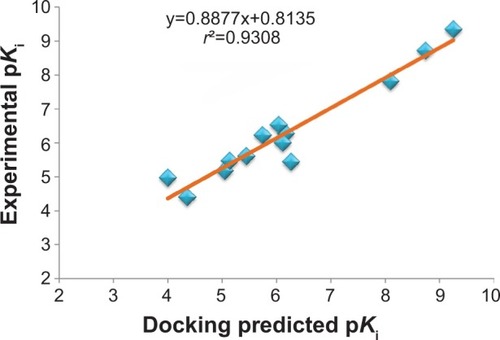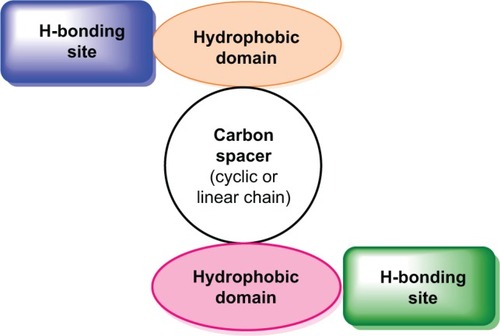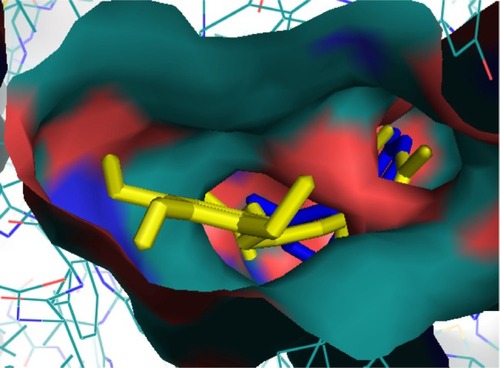Abstract
Ginger (Zingiber officinale), despite being a common dietary adjunct that contributes to the taste and flavor of foods, is well known to contain a number of potentially bioactive phytochemicals having valuable medicinal properties. Although recent studies have emphasized their benefits in Alzheimer’s disease, limited information is available on the possible mechanism by which it renders anti-Alzheimer activity. Therefore, the present study seeks to employ molecular docking studies to investigate the binding interactions between active ginger components and various anti-Alzheimer drug targets. Lamarckian genetic algorithm methodology was employed for docking of 12 ligands with 13 different target proteins using AutoDock 4.2 program. Docking protocol was validated by re-docking of all native co-crystallized ligands into their original binding cavities exhibiting a strong correlation coefficient value (r 2=0.931) between experimentally reported and docking predicted activities. This value suggests that the approach could be a promising computational tool to aid optimization of lead compounds obtained from ginger. Analysis of binding energy, predicted inhibition constant, and hydrophobic/hydrophilic interactions of ligands with target receptors revealed acetylcholinesterase as most promising, while c-Jun N-terminal kinase was recognized as the least favorable anti-Alzheimer’s drug target. Common structural requirements include hydrogen bond donor/acceptor area, hydrophobic domain, carbon spacer, and distal hydrophobic domain flanked by hydrogen bond donor/acceptor moieties. In addition, drug-likeness score and molecular properties responsible for a good pharmacokinetic profile were calculated by Osiris property explorer and Molinspiration online toolkit, respectively. None of the compounds violated Lipinski’s rule of five, making them potentially promising drug candidates for the treatment of Alzheimer’s disease.
Introduction
Alzheimer’s disease (AD) is a progressive neurodegenerative disorder of the central nervous system that accounts for 60%–70% of dementia cases in persons over 65 years of age worldwide.Citation1 Neurodegeneration in AD, and other neurodegenerative diseases appear to be multifactorial, in that a complex set of deleterious reactions including glutamatergic neurotoxicity, increases in iron and nitric oxide, reduced expression of trophic factors, dysfunction of the ubiquitin–proteasome system, depletion of endogenous antioxidants, expression of proapoptotic proteins, and inflammation leads to the decease of neurons.Citation2,Citation3 With human life span increasing and with decreasing cognitive functions in elderly individuals with AD-related dementia, AD has become a major health problem in society.Citation4
As of today, there are only few US Food and Drug Administration (FDA)-approved drugs in the market for treating AD patients. These include acetylcholinesterase (AChE) inhibitors (tacrine, donepezil, rivastigmine) and a noncompetitive inhibitor of N-methyl-D-aspartate (NMDA) receptors, memantine. All of these drugs improved the cognitive functions of AD patients symptomatically and have thus improved the quality of life for these patients; however, these drugs do not modify the disease progression in the long run.Citation5 Additionally, they show limited clinical effects over the shorter term for some patients, mild to moderate cholinergic adverse effects in a minority of patients, and potentially distressing toxicity over the longer term.Citation6
Furthermore, a great number of drugs with a variety of targets and clusters of mechanisms are currently in various stages of basic and clinical investigation. However, the development of therapies for this devastating disorder has been perturbing for physicians, researchers, and the pharmaceutical industry, with many drug candidates showing promise at one stage of clinical research only to fall at the next hurdle.Citation7 Consequently, no ensuing experimental drug in development has been successful thus far; there has not been a new drug marketed for AD in a decade.Citation6 The paucity of currently available drugs for treating AD, and their limited targets in AD pathology, as well as their proven side effects demand the development of a new generation of drugs that not only affect cholinergic functions associated with AD but also target other cellular pathways in AD pathogenesis.
Owing to the complexity of AD pathogenesis, the classic “one molecule, one target” solution may not be effective enough.Citation8 Recently, the novel multi-target-directed strategy has received avid attention of researchers, since single molecules simultaneously interact with multiple targets in complex neurotoxic cascades, may achieve better efficacy in a complementary manner. Meanwhile, multi-targeted drugs would have a larger therapeutic window than those hitting a single target and would thus prove to be safer drugs.Citation9
Since ancient times, the beneficial effects of some natural compounds have been appreciated in preventing various age-related pathologic conditions, including brain aging as well as neurodegeneration, and have been invigorated by a plethora of experimental and epidemiological studies.Citation2 Ginger (Zingiber officinale [Z. officinale]) is a common dietary adjunct that contributes to the taste and flavor of foods. In addition to its flavor, ginger is known to contain a number of potentially bioactive phytochemicals, mainly gingerols and their related dehydrating products, the shogaols () as well as volatile oils.Citation10
Figure 1 Chemical structure of potential bioactive phytochemicals from Zingiber officinale.
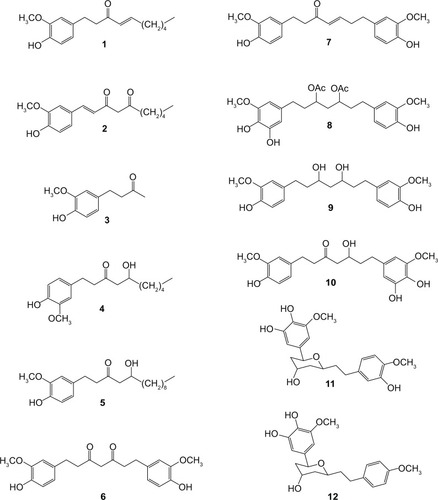
Gingerols are pungent principles in the rhizome of ginger and possess the labile β-hydroxy keto functional group, which makes it susceptible to transformation to less-pungent compounds such as shogaols and zingerone by elevated temperature. Gingerols and shogaols have been reported to exhibit many interesting pharmacological and physiological functions, for example, antipyretic, cardiotonic, chemopreventive, anti-inflammatory, and antioxidant properties.Citation11–Citation14 It has been reported that ginger extract inhibits the production of nitric oxide (NO) and proinflammatory cytokines in lipopolysaccharide (LPS)-stimulated BV-2 microglial cells via the NF-κB (nuclear factor kappa-light-chain-enhancer of activated B cells) pathway.Citation15 An inhibitory effect by 6-gingerol was shown on the production of proinflammatory cytokines in murine peritoneal macrophages.Citation16 Likewise, 6-shogaol has been shown to inhibit LPS-induced inducible nitric oxide synthase (iNOS) and cyclooxygenase (COX) gene expression in macrophages.Citation14 Moreover, 6-shogaol showed significant neuroprotective effects in vivo in transient global ischemia via the inhibition of microglia. It suppressed the microglial activation induced by LPS both in primary cortical neuron-glia culture and in an in vivo neuroinflammatory model.Citation17 In vitro data have shown that ginger’s active principles protect nerve cells and may have potential in the treatment of AD.Citation18
Anti-Alzheimer potential of gingerol has been disclosed more precisely when it was reported that it attenuates β-amyloid-induced oxidative cell death via fortifying cellular antioxidant defense system. In the said study, [6]-gingerol pretreatment protected against Aβ25–35-induced cytotoxicity and apoptotic cell death such as DNA fragmentation, disruption of mitochondrial membrane potential, elevated Bax/Bcl-2 ratio, and activation of caspase-3.Citation19 In addition, the potential of traditional Chinese medicinal ginger root extract has been assessed for its ability to prevent behavioral dysfunction in the Aβ-induced AD model in rats very recently.Citation20 Ginger’s potential in AD treatment has been further ascertained when its extract inhibited AChE activity as well as lipid peroxidation in the brain in a dose-dependent manner.Citation21 Various mechanisms by which ginger compounds elicit interesting pharmacological activities have been presented in .
Table 1 Various mechanisms associated with ginger
Molecular docking is a computational method for finding out binding modes of ligands to their receptors rapidly, and is being applied consistently to drug design and discovery projects.Citation22–Citation25 Therefore, the present study seeks to employ this technique to investigate the binding interactions between active ginger components and various anti-Alzheimer drug targets. This will not only help in disclosing the interactions of ginger components with multi-targets but will also play an important role in revealing the anti-Alzheimer’s mechanisms as well as assist in lead optimization. In addition, drug-likeness score and molecular properties responsible for good pharmacokinetic profile were calculated by Osiris property explorer (www.organicchemistry.org/prog/peo/) and Molinspiration online toolkit (http://www.molinspiration.com/cgi-bin/properties) respectively.
Materials and methods
Molecular docking
Preparation of the protein receptor
The crystal structures of the protein–ligand complexes for the 13 AD-associated targets were used for the docking calculations (). They were downloaded from the Research Collaboratory for Structural Bioinformatics (RCSB) Protein Data Bank (PDB; http://www.rcsb.org/pdb/home/home.do). For each crystal structure, the crystallographic water molecules were removed, the missing hydrogen atoms were added, and the inhibitor from the crystal structure was used to define the active site.
Table 2 Protein targets with anti-Alzheimer’s effect or target enzymes of drug design selected for docking studies
Preparation of ligands
Structures of the 12 ginger compounds with proven in vitro and/or in vivo activity against various central nervous system insults were retrieved from the literature.Citation26 The structures of the ligands were drawn in ChemDraw 8.0 (PerkinElmer Informatics, Waltham, MA, USA) and converted to their three-dimensional structures in Chem3D 8.0 (PerkinElmer Informatics). Geometry optimization was done using PM3 method by MOPAC program (http://OpenMOPAC.net). Finally, all the compounds were saved in pdb format for further docking studies.
Docking simulation
Lamarckian genetic algorithm methodology was employed for docking simulations implemented in AutoDock 4.2 (The Scripps Research Institute, La Jolla, CA, USA).Citation27 The standard docking procedure was used for a rigid protein and a flexible ligand whose torsion angles were identified (for ten independent runs per ligand). A grid of 60, 60, and 60 points in x, y, and z directions was built with a grid spacing of 0.375 Å and a distance-dependent function of the dielectric constant was used for the calculation of the energetic map. The default settings were used for all other parameters.
Analysis and visualization of docking simulation results
At the end of docking, the best poses were analyzed for hydrogen bonding or π interactions and root mean square deviation (RMSD) calculations using Discovery Studio Visualizer 2.5 (Accelrys Software Inc., San Diego, CA, USA) and PyMol version 1.3 (The PyMOL Molecular Graphics System; Schrödinger, LLC, New York, NY, USA) programs. From the estimated free energy of ligand binding (ΔGbinding, kcal/mol), the inhibition constant (Ki) for each ligand was calculated ().
Table 3 Results obtained after docking of ginger compounds (1–12) with various protein targets
Calculation of pharmacokinetic parameters
Molinspiration online property calculation toolkit and Osiris property explorer were used to check the pharmaceutical fidelity of the drug candidates. Molecular descriptors, such as miLogP, the number of hydrogen bond donors, the number of hydrogen bond acceptors, the molecular mass of the compounds, topological polar surface area (TPSA), number of rotatable bonds, and violations of Lipinski’s rule of fiveCitation28 were calculated using Molinspiration online property calculation toolkit. Percentage of absorption (%ABS) was calculated by: %ABS =109-[0.345× TPSA] according to the method of Zhao et al.Citation29
Calculation of toxicity potential
Osiris Property Explorer was used to analyze various attributes of the drugs, such as toxicity, drug-likeness, and drug score.
Results and discussion
Validation of docking protocol
Initially, all the 13 native co-crystallized ligands were extracted from the receptor and re-docked within the inhibitor binding cavity of respective receptors in order to validate the docking calculations, reliability, and reproducibility of the docking parameters for the study. It was evident that the docked conformation of the ligands was almost superimposed with that of the respective co-crystallized ligands (). As a general rule, if the best-docked conformation of a ligand resembles the bound native ligand in the experimental crystal structure, the used scoring function is said to be successful. According to the method of validation cited in the literature,Citation30 the successful scoring function is the one in which the RMSD of the best-docked conformation is ≤2.0 Å from the experimental one. In this study, RMSD values of all docked targets were within 2.0 Å (), indicating that our docking protocol is valid for the given structures and AutoDock 4.2, therefore deemed reliable for docking ginger components into the inhibitor binding cavity of multiple targets implicated in the pathogenesis of AD.
Figure 2 The validation of accuracy and performance of AutoDock 4.2.
Abbreviations: AChE, acetylcholinesterase; TACE, TNF-α converting enzyme; BuChE, butyrylcholinesterase; NOS, nitric oxide synthase; PDE-5, phosphodiesterase-5; NMDA, N-methyl-D-aspartate; COX, cyclooxygenase; hCE-1, human carboxylesterase-1; GSK, glycogen-synthase-kinase-3β; BACE, β-site amyloid precursor protein cleaving enzyme; ACE, angiotensin-converting enzyme; JNK, c-Jun N-terminal kinase.
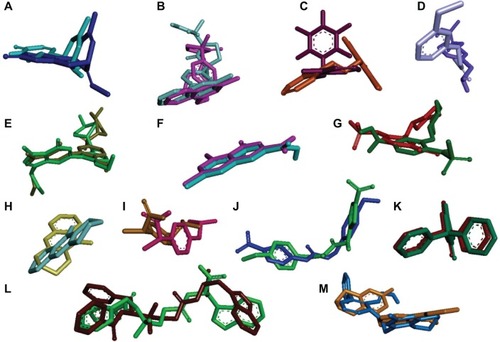
In addition, all of the experimentally reported and docking predicted binding affinity data were converted to their logarithmic scale and plotted to obtain a correlation coefficient r 2 of 0.931 (). It means that the docking methodology employed in the present study could be a promising computational tool to aid optimization of lead compounds obtained from ginger. In addition, the docked conformation of each ligand was compared with the respective crystal structure conformation by calculating RMSD values and satisfactory results were achieved ().
Interaction of the ginger compounds with potential protein targets
Thirteen potential protein receptors, which are either conventional clinical targets with anti-Alzheimer’s effects or target enzymes of drug design, were selected for docking studies. Docking predicted as well as experimentally reported Ki values for native co-crystallized ligands, PDB codes and related citation is presented in . For every target protein, a total of ten poses were visualized for each of the 12 ginger compounds to identify the model with minimum binding energy and estimated Ki values as well as best ligand–receptor interaction. The results in terms of binding free energy, predicted Ki, RMSD, number of hydrophobic as well as hydrophilic interaction are presented in . Since the values of docking predicted Ki, belong to different scales, they were converted to pKi (negative logarithm of Ki) values in order to have uniform data for a comparative study. A comparison of docking predicted activities of ligands against respective targets demonstrated in implicates that all of the docked ginger compounds possess the properties of promiscuous drugs.
Figure 4 Plot between docked targets and negative logarithmic values of docking predicted Ki of ginger compounds.
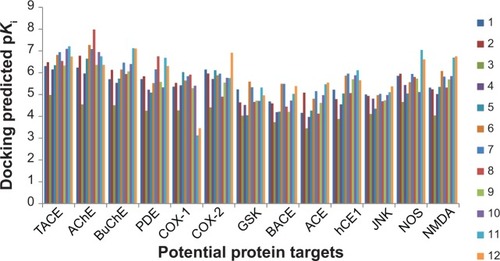
Natural products are a rich source of lead compounds. Many of today’s medicines are either obtained directly from a natural source or were developed from a lead compound originally obtained from a natural source. In initial stage, the level of activity associated with lead compound may not be prodigious and there may be undesirable side effects, but the lead compound provides a start for the drug design and development process. Drugs interacting with multiple targets might have a better chance of affecting the complex equilibrium of whole cellular networks than drugs that act on a single target. Ginger compounds were capable of interacting with all docked targets showing variable affinities, which indicated that these ligands have broad-spectrum structural features that make them proficient for recognizing numerous significant target proteins. reveals common structural features essential for activity.
It is evident from the plot presented in that AChE is the most promising and JNK (c-Jun N-terminal kinase) is the least favorable anti-Alzheimer’s drug target. In addition, butyrylcholinesterase (BuChE), TNF-α converting enzyme, COX-2, NOS, and NMDA are proposed as best putative targets for ginger’s bioactive phytochemicals. Docked ligand–protein complexes of most promising compounds in various potential targets are presented in .
Figure 6 3D structures of proteins showing the binding sites (left), and main residues involved in the ligand–protein (right) interaction of compound 8 and AChE (A, B), compound 11 and TACE (C, D), compound 11 and BuChE (E, F), and compound 11 and NOS (G, H).

Various experimental reports have evidenced that ginger extract is capable of inhibiting targets such as AChE, BuChE,Citation31 COX-1, COX-2, JNK, and NOS.Citation32 demonstrates the biological activities of ginger compounds or extracts that have been reported in the literature.Citation14–Citation17,Citation19,Citation21,Citation32–Citation40 Due to the molecular complexity of AD, multi-targeted therapies are becoming increasingly important as, in the long-term, they maximize the therapeutic effect and overcome the adverse effects associated with combination therapy.Citation9 Thus, the potential of multi-targeted therapies that have been identified in ginger compounds may be a key explanation for why ginger extract is effective as an anti-Alzheimer’s treatment.Citation14–Citation17,Citation19,Citation21,Citation32–Citation40 In addition, it has been recognized that ginger in folklore medicinal practice possesses various pharmacological properties due to the different components attacking various targets or different steps in the pathologic process of AD.Citation21 Therefore, the components of ginger, which have different mechanisms of anti-Alzheimer action, interact primarily in an additive or synergistic manner. A single drug should be more economical and lead to fewer adverse effects than a combination with each drug targeting a different protein.
Structure–activity relationship study presented in identifies the importance of various functionalities for ligand-receptor interactions: 1) replacement of distal hydrophobic domain (phenyl ring) with methyl group (compound 3) is detrimental for activity in all targets; 2) in hydrogen-bonding area, p-OH and m-OCH3 groups are important for all targets; additional m-OH is beneficial for most targets except glycogen-synthase-kinase-3β and β-site amyloid precursor protein cleaving enzyme; 3) double bond between C1 and C2 in compound 2 appreciates the activity at COX-1, COX-2, NOS, and angiotensin converting enzyme (ACE); however, double bond between C4 and C5 in compound 1 improves the activity at COX-2, glycogen-synthase-kinase-3β and JNK; 4) C3 and/or C5 must be substituted with C=O, OH, and OAc groups for optimum activity at all targets; 5) carbons C1 and C5 may be cyclized to form tetrahydropyran, which is essential for the activity of compounds 11 and 12 at NMDA, BuChE, ACE, JNK, and NOS; 6) for maximum activity, R should be aromatic ring substituted with H-bond donor/acceptor group at para and/or meta positions for all targets; 7) compounds having linear chain as carbon spacer are moderate or poor in activity; however, compounds 1 and 5 have exhibited appreciable activity at COX.
Figure 7 An overview of the structural requirements of ginger compounds for their interaction with different target receptors associated with Alzheimer’s disease.
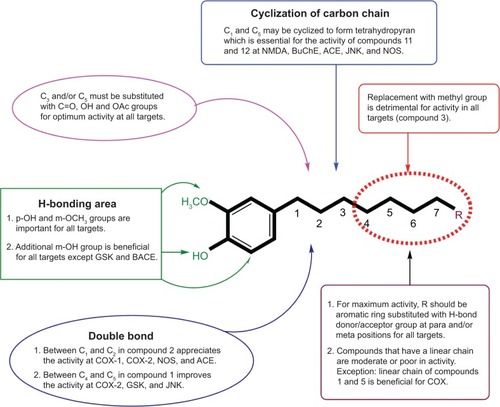
Binding interactions between ginger components and most promising target, AChE
Comparative analysis of the docking results revealed that AChE is the most favorable target for interaction of ginger components (). The neuropathology of AD is characterized by early loss of basal forebrain cholinergic neurons, leading to decreased cholinergic transmission, which can be improved with AChE inhibitors or by modulation of muscarinic and nicotinic acetylcholine receptors. In folklore medicine, ginger has been reportedly used for the treatment of AD as ginger extract, ginger tea, or as inclusion in food formulations and preparation.Citation21 Inhibition of AChE activity by extract of Z. officinale has been documented in an in vitro study where white ginger caused higher AChE inhibition than the red ginger.Citation21
Due to differences in substrate specificity and susceptibility to various kinds of inhibitors, cholinesterases were divided into two types: AChE, which hydrolyzes acetylcholine, and BuChE, which is able to hydrolyze larger molecules, such as butyrylcholine.Citation41,Citation42 AChE is the main enzyme metabolizing acetylcholine. It is also responsible for cerebral blood flow modulation, β-amyloid aggregation, activation and expression of APP95 protein, τ protein phosphorylation and has an influence on inflammatory processes. It interacts with β-amyloid, leading to creation of stable complexes and formation of senile plaques.Citation43,Citation44 The other enzyme, BuChE, is also important, because of its ability to hydrolyze acetylcholine and other choline esters. It was observed that the BuChE level increases in AD patients. Its role is not fully understood, but some studies suggested that it could promote amyloid plaque formation, and therefore, the search for inhibitors of both enzymes has been undertaken for the treatment of AD.Citation45,Citation46
Native co-crystallized ligand, Huperzine A is surrounded by residues Trp-86, Tyr-119, Gly-120, Gly-121, Gly-122, Tyr-124, Ser-125, Gly-126, Tyr-133, Glu-202, Ser-203, Tyr-337, and His 447, constituting active site of AChE enzyme (). All of the docked compounds utilized the same amino acids of inhibitor binding pocket for polar as well as nonpolar interactions. The active site of AChE is composed of a catalytic triad (Ser-203, Glu-334, and His-447) that sits at the bottom of a narrow ~20 Å deep gorge. Just at the mouth of the gorge is the peripheral anionic binding site, which is composed of Tyr-72, Asp-74, Tyr-124, Glu-285, Trp-286, and Tyr-341 (). Compounds 4, 9–10, and 12 utilized Tyr-72 and Tyr-124 for hydrophilic interaction while hydrophobic π–π interaction was noted with Trp-286 and Tyr-341 in the peripheral anionic-binding site. None of the compounds interacted with the residues of the catalytic triad except compound 10, which used phenyl ring for sharing π–π interaction with His-447.
Figure 8 The lowest energy configuration of docking result of compound 7 with binding pocket of acetylcholinesterase.
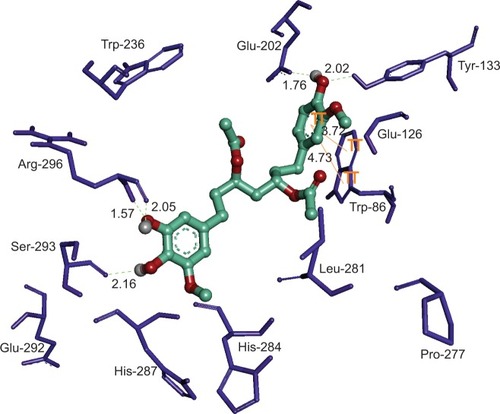
The oxy-anionic hole comprises Gly-120, Gly-121, and Ala-204. Compound 4 and 12 shared H-bond with Gly-120 of oxy-anionic hole. The choline-binding site is defined mostly by Trp-86. Compounds 1–4, and 6 used Trp-86 for hydrophobic interaction with choline binding site. Compound 7 appears to interact with AChE most persuasively (), conferring minimum binding energy among the docked compounds. The binding interactions are dominated by polar interactions involving hydroxyl group of Tyr-133, and carboxylic groups of Glu-202, Ser-293, and Arg-296. van der Waals contacts in terms of π–π interactions were noted with Trp-86. This compound has exploited the residues of ligand-binding area (Glu-202 and Trp-86) to demonstrate its maximum potency (). In general, the docking energies are lower for all ligands in BuChE in comparison to AChE ().
Prediction of pharmacokinetic properties
A successful oral drug is one that is promptly and completely absorbed from the gastrointestinal tract, distributed specifically to its site of action in the body, metabolized in a way that does not instantly remove its activity, and eliminated in a suitable manner, without causing any harm to the organs. It is a well-known fact that approximately half of all drugs in development fail to make it to the market because of poor pharmacokinetics (PK).Citation28 The PK properties depend on the chemical descriptors of the molecule. Computational prediction of PK properties such as absorption, distribution, metabolism, excretion, and toxicity (ADMET) have become progressively important in drug selection and promotion process and are promising tools to determine the success of the compound for human therapeutic use.Citation47 Therefore, early prediction of ADMET properties has been done with the objective of increasing the success rate of the ginger compounds in future development processes.
Molinspiration online property calculation toolkit was utilized to screen the ginger compounds as drug candidate based on Lipinski’s rule of five and the results are presented in . This rule is based on the surveillance that most orally administered drugs have a molecular weight of ≤500, a LogP (logarithm of partition coefficient) ≤5, five or fewer hydrogen bond donor sites, and ten or fewer hydrogen bond acceptor sites. Molecules violating more than one of these rules may have problems with bioavailability. Fortunately, none of the compounds under study has violated these criterions.
Table 4 Physicochemical parameters for good oral bioavailability of ginger compounds (1–12)
In addition, the bioavailability of ginger compounds was judged through TPSA analysis. This descriptor has been reported to correlate with passive molecular transport through membranes and therefore, allows prediction of transport properties of drugs and has been linked to drug bioavailability. As per the Veber’s rule for good oral bioavailability, the number of rotatable bond must be ≤10, and TPSA values ≤140 Å2.Citation48 The number of rotatable bonds has been shown to be a very good descriptor of oral bioavailability of drugs. Rotatable bond is defined as any single non-ring bond, bounded to non-terminal heavy (ie, non-hydrogen) atom. Amide C–N bonds are not considered because of their high rotational energy barrier. With exception of compounds 5 and 8, number of rotatable bonds was found to be appropriate in all ginger compounds.
Percentage of absorption was estimated using the equation: %ABS =109-0.345× TPSA, according to Zhao et al.Citation29 TPSA was also calculated using Molinspiration online property calculation toolkit according to the fragment-based method of Ertl et al.Citation49 Generally, it has been seen that passively absorbed molecules with a TPSA >140 Å2 are thought to have low oral bioavailability. According to the above criterions, calculated percentages of absorption for ginger compounds 1–12, ranged between 68.82% and 92.95%.
Toxicity risks and drug score assessment
Nowadays, it is much more convenient to predict the toxicity risks of compounds through reliable bioinformatics tools. In the present study, Osiris property explorer was used to calculate toxicity risks parameters such as mutagenicity, tumorigenicity, irritation, and reproductive or developmental toxicity of all the ginger compounds, 1–12 (). The predictions are based on the functional group similarity for the query molecule with the in vitro and in vivo validated compounds present in the database of this online program. The toxicity risk predictor locates fragments within a molecule, which indicate a potential toxicity risk. The results can be visualized using color codes; green color shows low toxic tendency, yellow shows the mediocre, and red color shows high tendency of toxicity. Toxicity screening results presented in showed that none of the compounds (1–12) pose the risk of tumorogenicity and reproductive toxicity; however, compound 1 indicated high risk of mutagenicity. On the other hand, compounds 2 and 3 indicated high risk of irritation.
Table 5 Drug-likeness/scores and toxicity calculations of ginger compounds based on Osiris property explorer
To assess the ginger compound’s overall potential to qualify for a drug, overall drug score was calculated, which combines drug-likeness, hydrophobicity (LogP), aqueous solubility (LogS), MW, and toxicity risk parameters. The hydrophobicity of drugs could be inferred from LogP value. LogP values are directly proportional to the oral hydrophobicity of the drug. The more hydrophobic the drug, higher is the ability of the drug to circulate longer in our body. It would not be easy to excrete such a drug. In the present investigation, the miLogP values of the drug molecules were observed to be in the range of 1.51–5.23 ().
Conclusion
In present study, a comparative molecular docking approach using AutoDock was taken to identify the potential anti-Alzheimer receptors for ginger bioactive phytochemicals such as gingerols, shogaols, zingerone, and related compounds. The results show that: 1) several targets such as AChE, BuChE, TNF-α converting enzyme, NOS, COX-2, and NMDA, identified in this study are proposed as best putative targets for ginger phytochemicals; 2) a number of targets identified by docking, such as AChE, BuChE, COX-1, COX-2, JNK, and NOS, have already been verified by experiments for their inhibition by ginger extracts; 3) it is being proposed that 1,3-diacetoxy derivative (compound 7) binds to the AChE active site with certain orientation and conformation so that it may act as an inhibitor of that enzyme. Structure analysis shows that electrostatic interaction and hydrogen bonding play an important role in their binding process. The study provides important information for optimizing lead compounds of ginger for the treatment of AD.
Disclosure
The authors have no conflicts of interest to disclose.
References
- Fan LY Chiu MJ Combotherapy and current concepts as well as future strategies for the treatment of Alzheimer’s disease Neuropsychiatr Dis Treat 2014 10 439 451 24648738
- Azam F Therapeutic potential of free radical scavengers in neurological disorders Kozyrev D Slutsky V Handbook of Free radicals: Formation, Types and Effects New York Nova Publishers 2010 57 97
- Mandel S Youdim MB Catechin polyphenols: neurodegeneration and neuroprotection in neurodegenerative diseases Free Radic Biol Med 2004 37 3 304 317 15223064
- Chancellor B Duncan A Chatterjee A Art therapy for Alzheimer’s disease and other dementias J Alzheimers Dis 2014 39 1 1 11 24121964
- Allain H Bentue-Ferrer D Tribut O Gauthier S Michel BF Drieu-La Rochelle C Alzheimer’s disease: the pharmacological pathway Fundam Clin Pharmacol 2003 17 4 419 428 12914543
- Schneider LS Alzheimer disease pharmacologic treatment and treatment research Continuum (Minneap Minn) 2013 19 2 Dementia 339 357 23558481
- Hampel H Current insights into the pathophysiology of Alzheimer’s disease: selecting targets for early therapeutic intervention Int Psychogeriatr 2012 24 Suppl 1 S10 S17 22784422
- Azam F Madi AM Ali HI Molecular docking and prediction of pharmacokinetic properties of dual mechanism drugs that block MAO-B and adenosine A2A J Young Pharm 2012 4 3 184 192 23112538
- Morphy JR Harris CJ Designing Multi-Target Drugs RSC Drug Discovery Series No. 21 Cambridge Royal Society of Chemistry 2012
- Silva MI de Melo CTV Vasconcelos LF de Carvalho AMR Sousa FCF Bioactivity and potential therapeutic benefits of some medicinal plants from the Caatinga (semi-arid) vegetation of Northeast Brazil: a review of the literature Brazilian Journal of Pharmacognosy 2012 22 193 207
- Shukla Y Singh M Cancer preventive properties of ginger: a brief review Food Chem Toxicol 2007 45 5 683 690 17175086
- Surh Y Molecular mechanisms of chemopreventive effects of selected dietary and medicinal phenolic substances Mutat Res 1999 428 1–2 305 327 10518003
- Ali BH Blunden G Tanira MO Nemmar A Some phytochemical, pharmacological and toxicological properties of ginger (Zingiber officinale Roscoe): a review of recent research Food Chem Toxicol 2008 46 2 409 420 17950516
- Pan MH Hsieh MC Hsu PC 6-Shogaol suppressed lipopolysaccharide-induced up-expression of iNOS and COX-2 in murine macrophages Mol Nutr Food Res 2008 52 12 1467 1477 18683823
- Jung HW Yoon CH Park KM Han HS Park YK Hexane fraction of Zingiberis Rhizoma Crudus extract inhibits the production of nitric oxide proinflammatory cytokines in LPS-stimulated BV2 microglial cells via the NF kappaB pathway Food Chem Toxicol 2009 47 6 1190 1197 19233241
- Tripathi S Maier KG Bruch D Kittur DS Effect of 6-gingerol on proinflammatory cytokine production and costimulatory molecule expression in murine peritoneal macrophages J Surg Res 2007 138 2 209 213 17291534
- Ha SK Moon E Ju MS 6-Shogaol a ginger product modulates neuroinflammation: a new approach to neuroprotection Neuropharmacology 2012 63 2 211 223 22465818
- Kim DS Kim DS Oppel MN Shogaols from Zingiber officinale protect human neuroblastoma and normal human umbilical vein endothelial cells from beta-amyloid (25–35) insult Planta Med 2002 68 4 375 376 11988870
- Lee C Park GH Kim CY Jang JH [6]-Gingerol attenuates β-amyloid-induced oxidative cell death via fortifying cellular antioxidant defense system Food Chem Toxicol 2011 49 6 1261 1269 21396424
- Zeng GF Zhang ZY Lu L Xiao DQ Zong SH He JM Protective effects of ginger root extract on Alzheimer disease-induced behavioral dysfunction in rats Rejuvenation Res 2013 16 2 124 133 23374025
- Oboh G Ademiluyi AO Akinyemi AJ Inhibition of acetylcholinesterase activities and some pro-oxidant induced lipid peroxidation in rat brain by two varieties of ginger (Zingiber officinale) Exp Toxicol Pathol 2012 64 4 315 319 20952170
- Shushni MA Azam F Lindequist U Oxasetin from Lophiostoma sp. of the Baltic Sea: identification, in silico binding mode prediction and antibacterial evaluation against fish pathogenic bacteria Nat Prod Commun 2013 8 9 1223 1226 24273851
- Azam F Prasad MV Thangavel N Shrivastava AK Mohan G Structure-based design, synthesis and molecular modeling studies of 1-(substituted aryl)-3-(thiazol-2-yl)urea derivatives as novel anti-Parkinsonian agents Med Chem 2012 8 6 1057 1068 22741780
- Azam F Prasad MV Thangavel N Structure-based design, synthesis and molecular modeling studies of 1-(benzo[d]thiazol-2-yl)-3-(substituted aryl)urea derivatives as novel anti-Parkinsonian agents Med Chem Res 2012 21 9 2630 2643
- Ahmed MA Azam F Rghigh AM Gbaj A Zetrini AE Structure-based design, synthesis, molecular docking and biological activities of 2-(3 benzoylphenyl) propanoic acid derivatives as dual mechanism drugs J Pharm Bioallied Sci 2011 4 1 43 50 22368397
- Peng F Tao Q Wu X Cytotoxic, cytoprotective and antioxidant effects of isolated phenolic compounds from fresh ginger Fitoterapia 2012 83 3 568 585 22248534
- Morris GM Goodsell DS Halliday RS Automated docking using a Lamarckian genetic algorithm and an empirical binding free energy function Journal of Computational Chemistry 1998 19 14 1639 1662
- Lipinski CA Lombardo F Dominy BW Feeney PJ Experimental and computational approaches to estimate solubility and permeability in drug discovery and development settings Adv Drug Deliv Rev 2001 46 1–3 3 26 11259830
- Zhao Y Abraham MH Le J Rate-limited steps of human oral absorption and QSAR studies Pharm Res 2002 19 10 1446 1457 12425461
- Wang R Lu Y Wang S Comparative evaluation of 11 scoring functions for molecular docking J Med Chem 2003 46 12 2287 2303 12773034
- Ghayur MN Gilani AH Ahmed T Muscarinic, Ca++ antagonist and specific butyrylcholinesterase inhibitory activity of dried ginger extract might explain its use in dementia J Pharm Pharmacol 2008 60 10 1375 1383 18812031
- Choi DK Koppula S Suk K Inhibitors of microglial neurotoxicity: focus on natural products Molecules 2011 16 2 1021 1043 21350391
- Bustamam A Ibrahim S Al-Zubairi AS Met M Syam MM Zerumbone: a natural compound with anti-cholinesterase activity Am J Pharmacol Toxicol 2008 3 3 209 211
- Shim S Kwon J Effects of [6]-shogaol on cholinergic signaling in HT22 cells following neuronal damage induced by hydrogen peroxide Food Chem Toxicol 2012 50 5 1454 1459 22381256
- Shin SG Kim JY Chung HY Jeong JC Zingerone as an antioxidant against peroxynitrite J Agric Food Chem 2005 53 19 7617 7622 16159194
- Kabuto H Nishizawa M Tada M Higashio C Shishibori T Koho M Zingerone [4-(4-hydroxy-3-methoxyphenyl)-2-butanone] prevents 6-hydroxydopamine-induced dopamine depression in mouse striatum and increases superoxide scavenging activity in serum Neurochem Res 2005 30 3 325 332 16018576
- Kiuchi F Iwakami S Shibuya M Hanaoka F Sankawa U Inhibition of prostaglandin and leukotriene biosynthesis by gingerols and diarylheptanoids Chem Pharm Bull 1992 40 2 387 391 1606634
- Wattanathorn J Jittiwat J Tongun T Muchimapura S Ingkaninan K Zingiber officinale mitigates brain damage and improves memory impairment in focal cerebral ischemic rat Evid Based Complement Alternat Med 2011 2011 429 505
- Belle NA Dalmolin GD Fonini G Rubim MA Rocha JB Polyamines reduces lipid peroxidation induced by different prooxidants agents Brain Res 2004 1008 2 245 251 15145762
- Kim SO Kundu JK Shin YK [6]-Gingerol inhibits COX-2 expression by blocking the activation of p38 MAP kinase and NF-kappaB in phorbol ester-stimulated mouse skin Oncogene 2005 24 15 2558 2567 15735738
- Ollis DL Cheah E Cygler M The alpha/beta hydrolase fold Protein Eng 1992 5 3 197 211 1409539
- Cygler M Schrag JD Sussman JL Relationship between sequence conservation and three-dimensional structure in a large family of esterases, lipases, and related proteins Protein Sci 1993 2 3 366 382 8453375
- Alvarez A Alarcon R Opazo C Stable complexes involving acetylcholinesterase and amyloid-beta peptide change the biochemical properties of the enzyme and increase the neurotoxicity of Alzheimer’s fibrils J Neurosci 1998 18 9 3213 3223 9547230
- Silman I Sussman JL Acetylcholinesterase: “classical” and “non-classical” functions and pharmacology Curr Opin Pharmacol 2005 5 3 293 302 15907917
- Musial A Bajda M Malawska B Recent developments in cholinesterases inhibitors for Alzheimer’s disease treatment Curr Med Chem 2007 14 25 2654 2679 17979717
- Darvesh S Cash MK Reid GA Martin E Mitnitski A Geula C Butyrylcholinesterase is associated with β-amyloid plaques in the transgenic APPSWE/PSEN1dE9 mouse model of Alzheimer disease J Neuropathol Exp Neurol 2012 71 1 2 14 22157615
- Moroy G Martiny VY Vayer P Villoutreix BO Miteva MA Toward in silico structure-based ADMET prediction in drug discovery Drug Discov Today 2012 17 1–2 44 55 22056716
- Veber DF Johnson SR Cheng HY Smith BR Ward KW Kopple KD Molecular properties that influence the oral bioavailability of drug candidates J Med Chem 2002 45 12 2615 2623 12036371
- Ertl P Rohde B Selzer P Fast calculation of molecular polar surface area as a sum of fragment-based contributions and its application to the prediction of drug transport properties J Med Chem 2000 43 20 3714 3717 11020286
- Cheung J Rudolph MJ Burshteyn F Structures of human acetylcholinesterase in complex with pharmacologically important ligands J Med Chem 2012 55 22 10282 10286 23035744
- McKinney M Miller JH Yamada F Tuckmantel W Kozikowski AP Potencies and stereoselectivities of enantiomers of huperzine A for inhibition of rat cortical acetylcholinesterase Eur J Pharmacol 1991 203 2 303 305 1800123
- Wandhammer M de Koning M van Grol M A step toward the reactivation of aged cholinesterases – crystal structure of ligands binding to aged human butyrylcholinesterase Chem Biol Interact 2013 203 1 19 23 22922115
- Cumming JN Smith EM Wang L Structure based design of iminohydantoin BACE1 inhibitors: identification of an orally available, centrally active BACE1 inhibitor Bioorg Med Chem Lett 2012 22 7 2444 2449 22390835
- Bhat R Xue Y Berg S Structural insights and biological effects of glycogen synthase kinase 3 specific inhibitor AR-A014418 J Biol Chem 2003 278 46 45937 45945 12928438
- Hicks JW Wilson AA Rubie EA Woodgett JR Houle S Vasdev N Towards the preparation of radiolabeled 1-aryl-3-benzyl ureas: radiosynthesis of [(11)C-carbonyl] AR-A014418 by [(11)C]CO(2) fixation Bioorg Med Chem Lett 2012 22 5 2099 2101 22321216
- Niu X Umland S Ingram R IK682, a tight binding inhibitor of TACE Arch Biochem Biophys 2006 451 1 43 50 16762314
- Duan JJ Chen L Wasserman ZR Discovery of gamma-lactam hydroxamic acids as selective inhibitors of tumor necrosis factor alpha converting enzyme: design, synthesis, and structure-activity relationships J Med Chem 2002 45 23 4954 4957 12408705
- Cao J Gao H Bemis G Structure-based design and parallel synthesis of n-benzyl isatin oximes as jnk3 map kinase inhibitors Bioorg Med Chem Lett 2009 19 10 2891 2895 19361991
- Fedorov R Hartmann E Ghosh DK Schlichting I Structural basis for the specificity of the nitric-oxide synthase inhibitors w1400 and nomega-propyl-l-arg for the inducible and neuronal isoforms J Biol Chem 2003 278 46 45818 45825 12954642
- Congreve M Chessari G Tisi D Woodhead AJ Recent developments in fragment-based drug discovery J Med Chem 2008 51 13 3661 3680 18457385
- Bencharit S Morton CL Hyatt JL Crystal structure of human carboxylesterase 1 complexed with the Alzheimer’s drug tacrine: from binding promiscuity to selective inhibition Chem Biol 2003 10 4 341 349 12725862
- Furukawa H Gouaux E Mechanisms of activation, inhibition and specificity: crystal structures of the NMDA receptor nr1 ligand-binding core EMBO J 2003 22 12 2873 2885 12805203
- Selinsky BS Gupta K Sharkey CT Loll PJ Structural analysis of NSAID binding by prostaglandin H2 synthase: time-dependent and time-independent inhibitors elicit identical enzyme conformations Biochemistry 2001 40 17 5172 5180 11318639
- Viegas A Manso J Corvo MC Marques MM Cabrita EJ Binding of ibuprofen, ketorolac, and diclofenac to COX-1 and COX-2 studied by saturation transfer difference NMR J Med Chem 2011 54 24 8555 8562 22091869
- Vecchio AJ Malkowski MG The structure of ns-398 bound to cyclooxygenase-2 J Struct Biol 2011 176 2 254 258 21843643
- Cryer B Feldman M Cyclooxygenase-1 and cyclooxygenase-2 selectivity of widely used nonsteroidal anti-inflammatory drugs Am J Med 1998 104 5 413 421 9626023
- Sung BJ Hwang KY Jeon YH Structure of the catalytic domain of human phosphodiesterase 5 with bound drug molecules Nature 2003 425 6953 98 102 12955149
- Jiang W Guan J Macielag MJ Pyrroloquinolone PDE5 inhibitors with improved pharmaceutical profiles for clinical studies on erectile dysfunction J Med Chem 2005 48 6 2126 2133 15771456
- Watermeyer JM Kroger WL O’Neill HG Sewell BT Sturrock ED Probing the basis of domain-dependent inhibition using novel ketone inhibitors of Angiotensin-converting enzyme Biochemistry 2008 47 22 5942 5950 18457420

